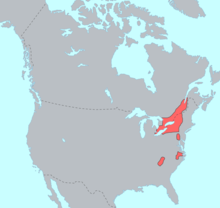Iroquois languages
Iroquois languages are related languages spoken by members of the Iroquois Federation and other peoples who originally lived in eastern North America . Around 1600, their settlement areas were mainly around Lake Huron and Lake Ontario, and they expanded somewhat towards the northeast ( Québec ). The language code according to ISO 639-2 is iro . Most of the 80,000 or so Iroquois no longer use the Iroquois languages as their mother tongue. Their number halved from around 20,000 (around 1600) to 1770 and has been rising sharply again since 1950.
Classification of the Iroquois languages
The Iroquois languages are now generally divided into a Northern Branch and a Southern Branch, with the latter now only represented by the Cherokee language. Several languages, such as Laurentian or the Erie language , were extinct before they could be documented, so that a clear classification is no longer possible today.
Most of the well-known Iroquois languages are now extinct (†) , the others are among the seriously endangered languages , the Mohawk and Cherokee are considered potentially endangered, the Mingo and Tuscarora are doomed languages . With the exception of the Cherokee, which uses the Cherokee syllabary developed by Sequoyah for rendering , all Iroquois languages are rendered using modifications of the Latin writing system .
I. NORTHERN Iroquois languages
-
A. Lake Iroquoian (Great Lakes Iroquois)
- i. Iroquois Proper, Five Nations-Susquehannock, Iroquois
-
a. Seneca-Cayuga or Western Iroquois
-
- 1. Seneca (Onödowá'ga: / Onötowá'ka :, approx. 100 speakers), see also the Seneca people
- 2. Cayuga (Gayogo̱hó: nǫ ', two dialects; approx. 61 speakers in Canada according to Census 2016 + less than 10 speakers in New York, USA), see also the Cayuga people
- Oklahoma Cayuga or Seneca Cayuga (approx. 1980 †)
- Ontario Cayuga
- Upper Ontario Cayuga subdialect (Upper End of the Six Nations)
- Lower Ontario Cayuga subdialect (Lower End of the Six Nations)
- 3. Mingo (Unyææshæötká '/ Ökwe'öwékhá', as "Western Seneca" sometimes just considered as another Seneca dialect, approx. 5 speakers, almost † )
- 4. Onondaga (Onǫda'gegá '/ Onoñda'gegá', two dialects; approx. 50 speakers)
- Ontario Onondaga
- New York Onondaga
- 5. Susquehannock (ca.1760 †)
-
- b. Mohawk – Oneida or Eastern Iroquois
- ii. Huronian, Huron-Wendat, Huron-Petun (Wendat-Tionontate)
- 8. Huron or Wendat (ca.1650 †)
- 9. Tionontati or Petun Huron (Tobacco / Tobacco) (approx. 1650 †)
- 10. Neutral or Neutral Huron (1650 †)
- 11. Wyandot (Waⁿdat, after the destruction of the confederations of the Huron, Petun and Neutral, the dialect of the newly grouped Wyandot developed into a separate language, around 1972 † )
- Determination / assignment not clear or possible (due to missing language documents)
- 12. Wenrohronon (Wenro) (ca.1650 †)
- 13. Eriechronon (Erie) ( ca.1650 †)
- 14. Laurentisch (several dialects, possibly even several languages, approx. 1580 † )
- 15. Massawomeck (similarities with the language of Erie or the Susquehannock, † )
B. Tuscarora-Nottoway (North Carolina Iroquois)
- 16. Tuscarora (Ska: rù: rę '/ Skarò˙rə̨ˀ, three dialects, approx. 3 speakers, almost † )
- 17. Cheroenhaka (Nottoway) (Dar-sun-ke, ca.1838 †)
- 18. Meherrin (Ska: rù: rę, approx. 1720 † )
- Determination / assignment not clear or possible (due to a lack of language documents, are often also assigned to the North Carolina-Algonquin )
II. SOUTHERN Iroquois languages
- 23. Cherokee (Tsalagi Gawonihisdi, ᏣᎳᎩ ᎦᏬᏂᎯᏍᏗ, three dialects, approx. 12,000 speakers)
Todays situation
| Nation (tribe) | population | language | speaker | % Proportion of | Distribution area - then and now | Remarks |
|---|---|---|---|---|---|---|
| Seneca | about 10,000 to 15,000 | Onödowá'ga: / Onötowá'ka | about 100 | 0.67 to 1.00 | New York State, USA, today: New York State, Oklahoma, USA + Ontario, Canada | Seneca – Cayuga Nation (mostly Seneca) |
| Cayuga | approx. 12,300 | Gayogo̱hó: nǫ ' | approx. 70 | 0.57% | New York State, USA, today: Oklahoma, USA + Ontario, Canada | Seneca – Cayuga Nation (mostly Seneca) |
| Mingo | ? | Unyææshæötká '/ Ökwe'öwékhá' | approx. 5 | Pennsylvania, Ohio, West Virginia, USA, today: Oklahoma, USA | Seneca – Cayuga Nation (mostly Seneca and Cayuga, no census available for Mingos) | |
| Onondaga | approx. 1,200 | Onǫda'gegá '/ Onoñda'gegá' | approx. 50 | 4.17 | New York State, USA, today: New York State, USA + Ontario, Canada | |
| Susquehannock | 1600: 6,000 to 7,000 | not handed down | no | 0 | New York State, Pennsylvania, Maryland, USA, today: New York State, Oklahoma, North Carolina, Virginia, Wisconsin, USA + Ontario, Canada | Descendants under the Meherrin, Nottoway and Mingo as well as Oneida |
See also
literature
- WL Chafe: The Caddoan, Iroquoian, and Siouan Languages . The Hague 1976.
- I. Goddard (Ed.): Languages. Handbook of North American Indians (WC Sturtevant) , Volume 17. Smithsonian Institution, Washington, DC 1996, ISBN 0-16-048774-9 .
- Ernst Kausen: The language families of the world. Part 2: Africa - Indo-Pacific - Australia - America. Buske, Hamburg 2014, ISBN 978-3-87548-656-8 . (Chapter 12)
- M. Mithun: Iroquoian . In: L. Campbell, M. Mithun (Eds.): The Languages of Native America . Austin, Texas 1979, pp. 133-212.
- M. Mithun: The languages of native North America . Cambridge University Press, Cambridge, 1999, ISBN 0-521-23228-7 (hbk); ISBN 0-521-29875-X .
- WL Chafe: A Semantically Based Sketch of Onondaga . Bloomington 1970.
- H.-J. Sasse: The Iroquois language type . In: Zeitschrift für Sprachwissenschaft 7, 1988, pp. 173-213.
- WL Chafe: Sketch of Seneca, an Iroquoian language (= I. Goddard (Ed.): Handbook of North American Indians, 17 ). Languages, Washington 1996, pp. 551-579.
